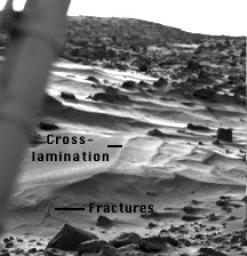
|
Wind Drifts at Viking 1 Landing Site
- Click the image above for a larger view
- Full-Res JPEG (216 x 224) (10.8 kB)
- Full-Res TIFF (216 x 224) (48.9 kB)
Caption:
This image is of so-called wind drifts seen at the Viking 1 landing site. These are somewhat different from the features seen at the Pathfinder site in two important ways. 1) These landforms have no apparent slip-or avalanche-face as do both terrestrial dunes and the Pathfinder features, and may represent deposits of sediment falling from the air, as opposed to dune sand, which "hops" or saltates along the ground; 2) these features may indicate erosion on one side, because of the layering and apparent scouring on their right sides. They may, therefore have been deposited by a wind moving left to right, partly or weakly cemented or solidified by surface processes at some later time, then eroded by a second wind (right to left), exposing their internal structure.
Background Info:
Mars Pathfinder is the second in NASA's Discovery program of low-cost spacecraft with highly focused science goals. The Jet Propulsion Laboratory, Pasadena, CA, developed and manages the Mars Pathfinder mission for NASA's Office of Space Science, Washington, D.C. JPL is a division of the California Institute of Technology (Caltech).
Photojournal note: Sojourner spent 83 days of a planned seven-day mission exploring the Martian terrain, acquiring images, and taking chemical, atmospheric and other measurements. The final data transmission received from Pathfinder was at 10:23 UTC on September 27, 1997. Although mission managers tried to restore full communications during the following five months, the successful mission was terminated on March 10, 1998.
Cataloging Keywords:
| Name | Value | Additional Values |
|---|---|---|
| Target | Mars | |
| System | ||
| Target Type | Planet | |
| Mission | Mars Pathfinder (MPF) | Viking |
| Instrument Host | Mars Pathfinder Lander | Viking 1 Lander |
| Host Type | Lander | |
| Instrument | ||
| Detector | ||
| Extra Keywords | Atmosphere, Dune, Grayscale | |
| Acquisition Date | ||
| Release Date | 1997-10-14 | |
| Date in Caption | ||
| Image Credit | NASA/JPL/USGS | |
| Source | photojournal.jpl.nasa.gov/catalog/PIA00990 | |
| Identifier | PIA00990 | |
